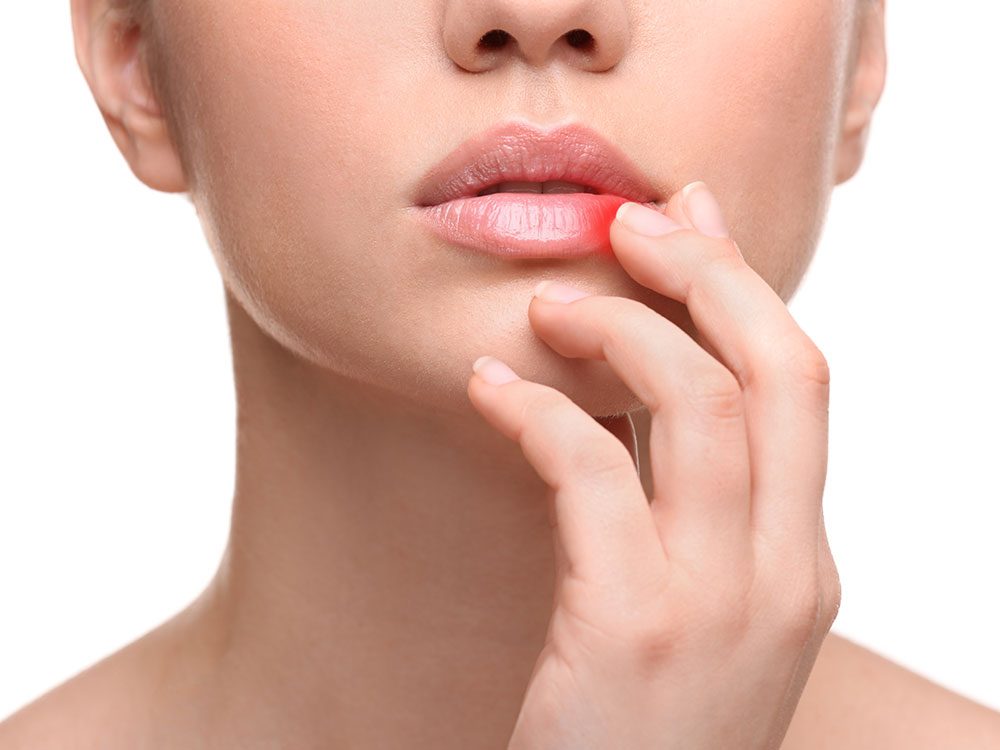11 Fever Blister Remedies That Actually Work
Whether you call it a fever blister or a cold sore, there’s no denying this common condition is painful. Although there’s no cure, there are a number of treatments worth trying—including these 11 effective options.

What is a Fever Blister?
A fever blister hides out in the nerves and becomes active as a result of stress, overexposure to sunlight, or hormonal changes, or when your immune system is weak. You usually get a warning of a fever blister (also known as a cold sore), which may include tingling, discomfort, itching, or aching. This is when you might consider using the remedies described here. Don’t wait until a blister erupts; by then, it’s often too late.
Home Remedies for a Fever Blister
To reduce the duration and severity of a fever blister outbreak, follow this advice at the first tingling.
- Apply a damp black tea bag to the area where the outbreak typically occurs. Keep it on for 10 minutes. Repeat three or four times a day. Why it works: Tea bags contain tannic acid, an astringent that has antiviral properties (which is why tannic acid is often an ingredient in over-the-counter fever blister remedies).
- Next, apply an ice pack to the same area. Keep the ice on for 15 minutes, and repeat three or four times a day. Why it works: Ice numbs the pain, and there’s some evidence it may also reduce the amount of virus created.
- After each ice application, thickly apply lemon balm ointment (70:1 concentration) to the area. Lemon balm is often sold in health food stores. Why it works: Test tube studies suggest that lemon balm (Melissa officinalis) prevents the virus from attaching to cells, thus blocking its ability to replicate. One well-designed study of 116 people with oral or genital herpes found those treated with the balm recovered much quicker than those receiving a placebo. Plus, there’s some evidence that using lemon balm during the initial outbreak (the very first time you realize you have a fever blister) may reduce the risk of recurrence.
- Now take 1 gram lysine along with 1,000 milligrams vitamin C that also contains 1,000 milligrams of flavonoids. Take up to five times a day until the recurrence ends. Why it works: Lysine is an amino acid that works as an antiviral by blocking the activity of another amino acid, arginine. Arginine provides “food” for the virus, enabling it to replicate. Cutting off this fuel source reduces the amount of virus in your system. One study of 53 people with oral and genital herpes found those who received lysine supplements and cut out arginine-rich foods had an average of 3.1 outbreaks over six months, compared to an average of 4.2 in the control group.
- Also take a baby aspirin (83 milligrams) once a day with food. Why it works: The aspirin helps relieves the pain of a fever blister and may also reduce healing time. One small study found participants who took an aspirin at the first sign of an outbreak, then continued taking it for several months, had far fewer outbreaks than a control group that didn’t take aspirin.
Other Treatments for a Fever Blister
Herbs and Supplements
6. Quercetin. Take 500 milligrams twice a day of this flavonoid, which laboratory studies find blocks fever blister viruses from replicating. (Here are 13 vitamins and supplements that doctors take every day.)
Over-the-Counter Drugs
7. Aloe vera cream or extract 0.05% strength. Apply three times a day for five days during outbreaks. Studies find it reduces healing time.
8. Zinc. Apply a topical zinc sulfate cream (0.01% to 0.025%) several times a day. This helps heal the sore and reduces the risk of a recurrence.
Prescription Drugs
9. Denavir (penciclovir). This is the only prescription-strength topical treatment found to be effective, with studies showing it helps fever blisters heal about a day faster than placebo.
10. Oral antivirals. As with genital herpes, you can take an oral antiviral such as Zovirax (acyclovir), Famvir (famciclovir), or Valtrex (valacyclovir) at the first sign of an outbreak to prevent the virus from replicating.
Other Approaches
11. Aromatherapy. Dilute 1 drop lavender, lemon balm, chamomile, bergamot, or rose oil in 10 drops jojoba oil (which serves as a carrier oil) and smooth over the affected area several times a day. Here are five more ways to tap the healing power of lavender.
Fever Blister Prevention
Avoid triggers. Two primary ones are a weak immune system and stress. (Try these 37 expert-approved strategies for managing stress.) Also avoid overexposure to sunlight and any trauma to the skin around the mouth, such as rough kissing.
Follow a high-lysine/low-arginine diet. (See details above.) Also add seaweed salads, sushi, or green drinks containing seaweed extracts (available in health food stores). Laboratory studies find that seaweed has antiviral properties.
Zinc. Take 25 milligrams of zinc by mouth every day. Zinc enhances immunity, helping to prevent fever blister recurrences. (Skip these eight vitamins that are a waste of money—and might even be dangerous.)
Selenium. Take 200 micrograms a day to help maintain a healthy immune system.
Lysine. If you have frequent recurrences of fever blisters, take 1 gram a day to prevent outbreaks, but don’t take if you have high cholesterol, because long-term use can increase levels of “bad” LDL cholesterol.
Mineral sunscreen. Wear a high-SPF sunscreen on your face, and apply zinc oxide to areas prone to fever blisters. Don’t miss these 10 sunscreen tips you should always follow to protect your skin.



